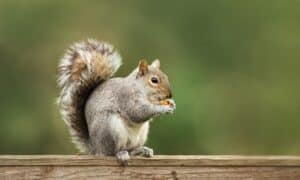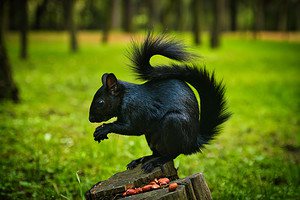
There are squirrels in every region of the lower 48 states.
©
Welcome to the wonderful world of squirrels! Across the United States, these furry, bushy-tailed creatures thrive. They play a crucial role in the ecosystem, spreading seeds and providing food for predators. But did you know that not all squirrels are equal?
In this article, we discover the eight largest squirrel species found in the U.S. So, join us on this exciting journey through the treetops and beyond!
1. The Eastern Gray Squirrel (Sciurus carolinensis)
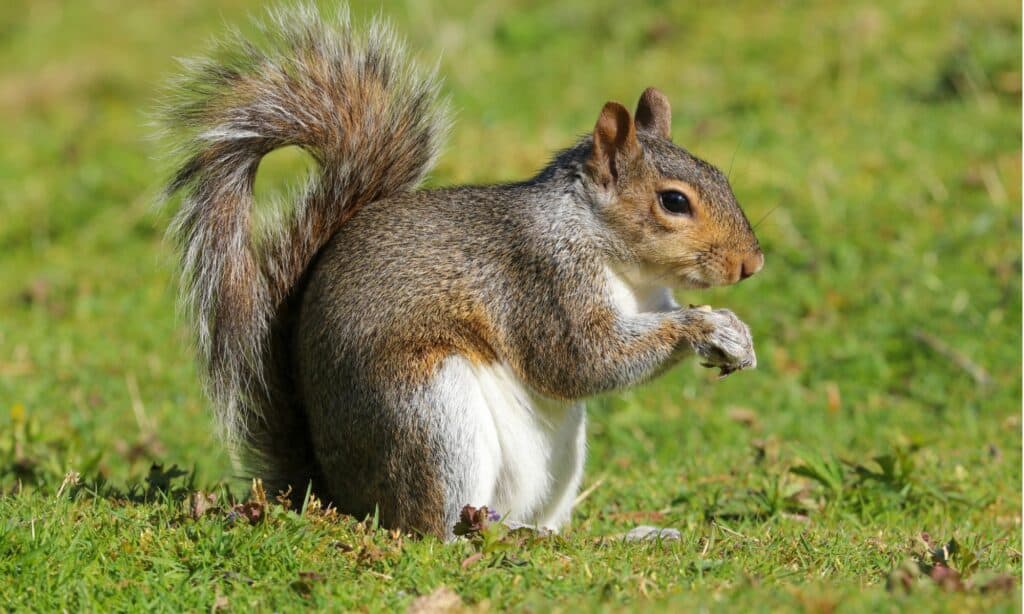
The eastern gray squirrel is native to the eastern and midwestern regions of the United States.
©iStock.com/Helen Davies
This squirrel species is a true symbol of American green spaces and suburban neighborhoods. This charming creature, known for its sleek gray fur, bushy tail, and acrobatic abilities, has captured the hearts of many. Let’s dive deeper into the fascinating world of the eastern gray squirrel.
Description and Size
Dressed in a gray coat, sometimes with a touch of reddish-brown, the eastern gray squirrel is quite a sight. Adults weigh 1-1.5 lbs., with males typically being larger than females. They can grow up to 20 inches long, with half of that length being their magnificent, fluffy tail that serves as a counterbalance during their tree-top escapades.
Where They Are Commonly Seen
The eastern gray squirrel is native to the eastern and midwestern regions of the United States. They favor deciduous and mixed forests, but their adaptability allows them to thrive in urban and suburban environments as well. They build their nests, called dreys, high up in the trees, using twigs, leaves, and other soft materials.
Diet and Behavior
Eastern gray squirrels have a diverse diet comprising nuts, seeds, fruits, fungi, and occasionally insects and small bird eggs. Acorns are a particular favorite, but they’ll happily snack on walnuts, hickory nuts, and even the occasional berry. They’re skilled foragers and have clever food-storing strategies, burying their treasures throughout their territory to dig up during leaner times.
These squirrels are diurnal, meaning they’re active during the day. However, they’re most active in the early morning and evening. They communicate using a range of vocalizations and tail movements, warning each other of potential dangers or asserting their dominance.
2. The Western Gray Squirrel (Sciurus griseus)

The Western Gray Squirrel inhabits mixed coniferous and hardwood forests, as well as
oak
woodlands
©iStock.com/Nancy Strohm
Now, let’s journey westward to meet the western gray squirrel, a close cousin of the eastern gray squirrel. With their distinct silver-gray coat and elegant, bushy tail, these squirrels are a captivating sight as they gracefully navigate their woodland habitats.
Description and Size
The western gray squirrel has beautiful silver-gray fur, which is darker on the back and lighter on the belly. Averaging 1.5-2.2 lbs., they’re slightly larger than their eastern relatives, with a total length of up to 24 inches, including their luxurious tail.
Where They Are Commonly Seen
Native to the western United States, the Western Gray Squirrel inhabits mixed coniferous and hardwood forests, as well as oak woodlands. They’re particularly fond of trees like oak, pine, and Douglas-fir, which provide shelter and sustenance.
Diet and Behavior
These squirrels have quite the palate, feasting on a variety of nuts, seeds, acorns, berries, and fungi. They’re particularly fond of pine seeds and acorns, which make up a significant portion of their diet. Just like their eastern counterparts, they stash away food to prepare for leaner times.
Western gray squirrels are also diurnal. You can often catch them foraging or sunbathing in the early morning and evening. They communicate with each other using vocalizations and tail signals to warn of potential threats or assert dominance.
3. The Fox Squirrel (Sciurus niger)
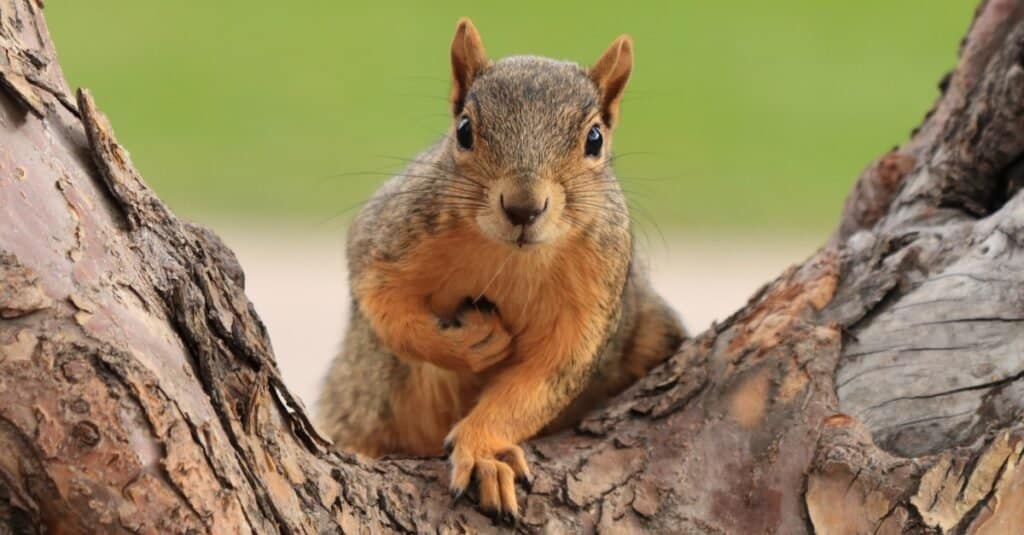
They are throughout the eastern and central United States, as well as parts of the western states.
©Vaclav Matous/Shutterstock.com
This is the largest tree squirrel species in North America. With their striking appearance and playful demeanor, they’re sure to captivate your attention as they frolic through the trees and across the forest floor.
Description and Size
Fox squirrels boast a remarkable coat that ranges from reddish-brown to gray, with a creamy or reddish-orange belly. Their impressive size sets them apart—they can weigh up to 2.5 lbs. and measure up to 28 inches long, including their bushy, foxlike tail.
Where They Are Commonly Seen
These adaptable creatures inhabit a wide range of environments, from mixed hardwood forests to urban parks and golf courses. They are throughout the eastern and central United States, as well as parts of the western states.
Diet and Behavior
The fox squirrel’s diet is diverse, including nuts, seeds, fruits, and even insects and bird eggs. They’re especially fond of acorns and hickory nuts, which they’ll hoard in preparation for the winter months.
Active during the day, these squirrels are scampering along the ground or leaping from branch to branch. They communicate with each other through a variety of vocalizations and tail movements to convey information about threats or territory boundaries.
4. The Abert’s Squirrel (Sciurus aberti)
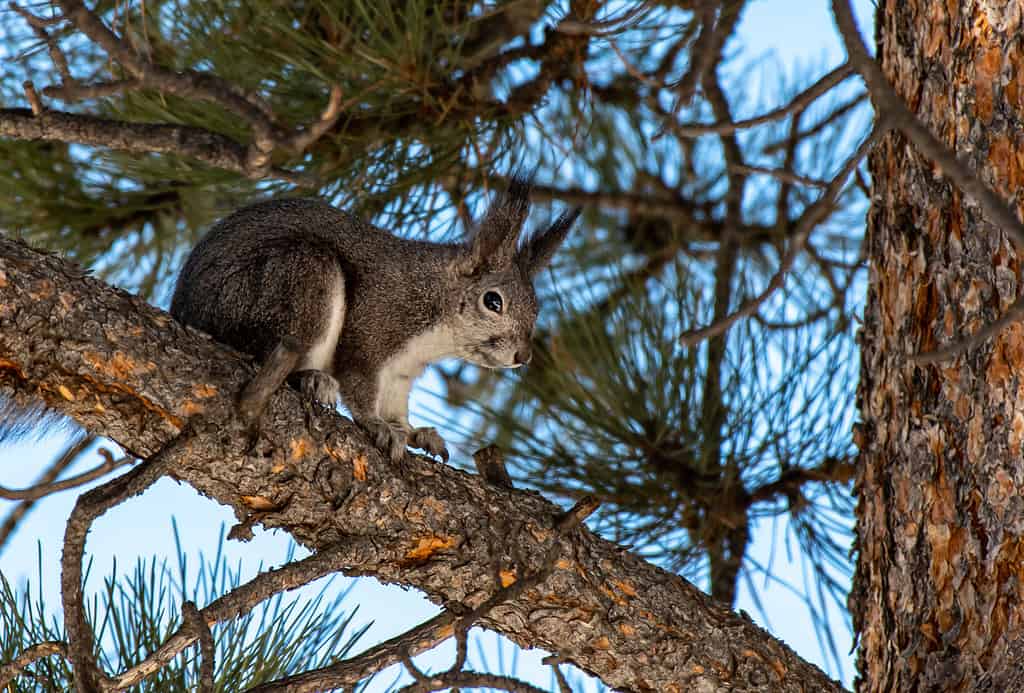
Abert’s squirrels are native to the southwestern United States, primarily in Arizona, New Mexico, Colorado, and Utah.
©Kerry Hargrove/Shutterstock.com
The unique and majestic Abert’s squirrel is also known as the tassel-eared squirrel. With their distinctive ear tufts and impressive size, these squirrels are a sight to behold as they navigate the forests of the southwestern United States.
Description and Size
The Abert’s squirrel is known for its dark gray or brown coat and striking ear tufts, which give them their “tassel-eared” nickname. They’re on the larger side, weighing 1.3-2.2 lbs. and measuring up to 23 inches long, including their bushy, silver-tipped tail.
Where They Are Commonly Seen
Abert’s squirrels are native to the southwestern United States, primarily in Arizona, New Mexico, Colorado, and Utah. They have a strong preference for ponderosa pine forests, where they build their nests and find their primary food source.
Diet and Behavior
Abert’s squirrels have a specialized diet, mainly consisting of ponderosa pine seeds, cones, and the inner bark. They also eat fungi, fruits, and other plant materials. Their diet varies seasonally, with cones being their primary food source during the fall and winter.
These squirrels are diurnal, often seen foraging or sunbathing during the day. Their vocalizations and tail movements are key components of their communication with each other, warning of potential danger or asserting their dominance within their territory.
5. The Douglas Squirrel (Tamiasciurus douglasii)

Native to the Pacific Northwest, Douglas squirrels inhabit coniferous and mixed forests throughout Washington, Oregon, and northern California.
©Randy Bjorklund/Shutterstock.com
Let’s explore the world of the Douglas squirrel, a lively and charismatic species that shares many similarities with the American red squirrel. With their richly colored fur and energetic disposition, they’re a delightful presence in the forests of the western United States.
Description and Size
The Douglas squirrel dons a reddish-brown or grayish coat on its back, with a bright orange or rust-colored belly. Smaller than some of their squirrel counterparts, they weigh 5-11 oz. and measure up to 14 inches long, including their bushy, expressive tail.
Where They Are Commonly Seen
Native to the Pacific Northwest, Douglas squirrels inhabit coniferous and mixed forests throughout Washington, Oregon, and northern California. They have a particular affinity for trees like Douglas-fir, spruce, and pine, which provide them with food and shelter.
Diet and Behavior
Douglas squirrels have a varied diet, feasting on seeds, nuts, fruits, fungi, insects, and bird eggs. They have a special fondness for conifer seeds, which they store in underground caches or their nests for later consumption.
These squirrels are diurnal, with peak activity in the early morning and evening. They’re territorial and use vocalizations and tail movements to communicate with each other, signaling potential danger or asserting their dominance.
6. The Northern Flying Squirrel (Glaucomys sabrinus)
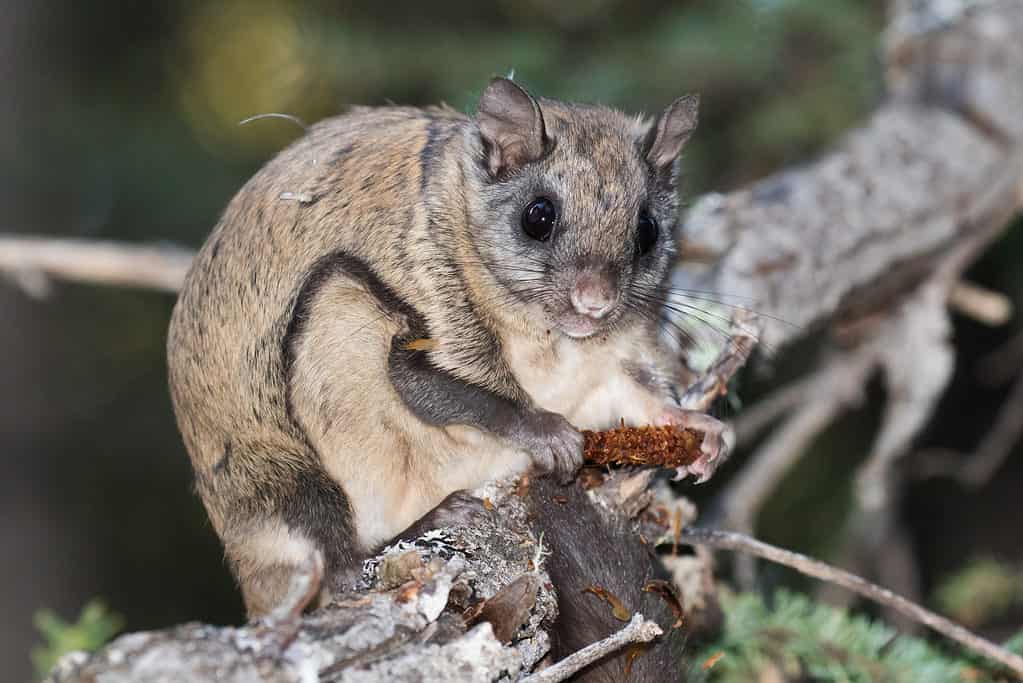
These nocturnal marvels inhabit coniferous and mixed forests across the northern United States,
Canada
.
©Jukka Jantunen/Shutterstock.com
Let’s venture north to meet the northern flying squirrel, a close relative of the southern flying squirrel, with its unique adaptations for life in cooler climates. These enchanting creatures are sure to delight you with their remarkable gliding abilities and charming appearance.
Description and Size
The northern flying squirrel is adorned with thick, reddish-brown, or grayish fur, providing insulation in colder temperatures. They typically weigh 2.5-4.5 oz. and measure up to 12 inches long, including their flat, bushy tail. Like their southern relatives, they possess the patagium, which enables them to glide through the air with ease.
Where They Are Commonly Seen
These nocturnal marvels inhabit coniferous and mixed forests across the northern United States, Canada, and even Alaska. They prefer habitats with an abundance of conifer trees, which provide ample opportunities for gliding and nesting.
Diet and Behavior
Northern flying squirrels have a varied diet, including seeds, nuts, fruits, insects, and bird eggs. They also rely heavily on fungi, especially truffles, which provide essential nutrients and play a crucial role in their forest ecosystem.
Like their southern counterparts, these squirrels are nocturnal and highly social, often nesting together for warmth during colder months. They use their remarkable gliding abilities to cover long distances, skillfully navigating the forest canopy using their tail as a rudder.
7. The Arizona Gray Squirrel (Sciurus arizonensis)
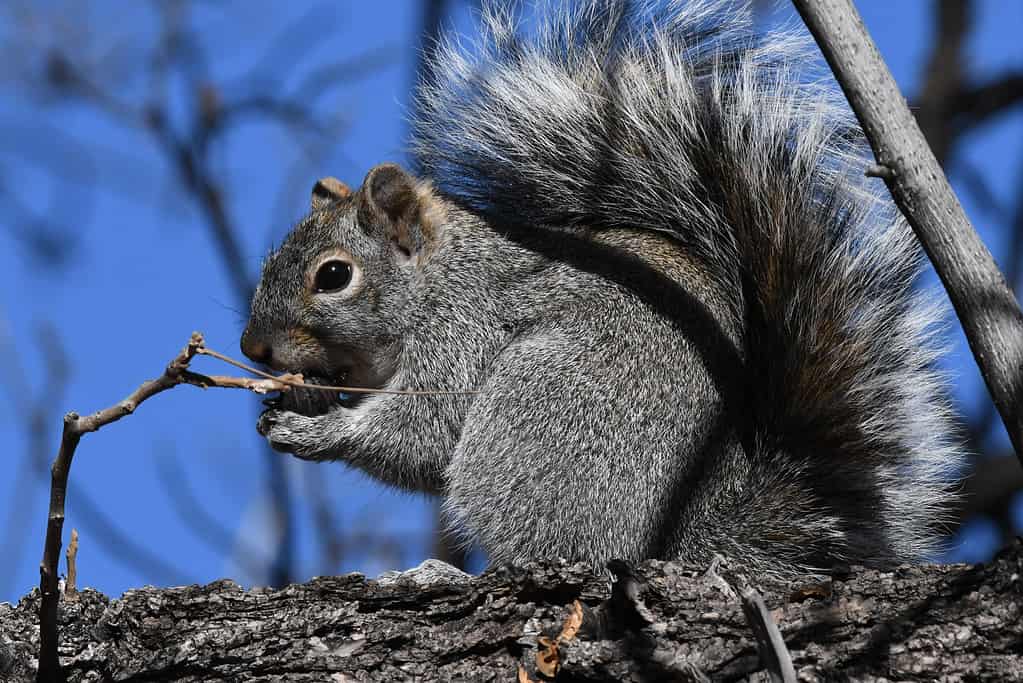
These charming squirrels are native to the southwestern United States, primarily found in Arizona and parts of New Mexico.
©Gilbert S. Grant/Shutterstock.com
This is a lesser-known yet delightful species that call the southwestern United States home. Their unique adaptations for life in riparian environments make them an intriguing addition to our list of squirrels.
Description and Size
The Arizona gray squirrel sports a silver-gray coat on its back, with a contrasting white or cream-colored belly. They typically weigh 1-1.5 lbs. and measure up to 18 inches long, including their bushy, silver-tipped tail.
Where They Are Commonly Seen
These charming squirrels are native to the southwestern United States, primarily found in Arizona and parts of New Mexico. They thrive in riparian environments, such as streamside woodlands, where they can find ample food and shelter among cottonwood, willow, and sycamore trees.
Diet and Behavior
Arizona gray squirrels enjoy a diverse diet, which includes acorns, seeds, nuts, fruits, and occasionally insects and bird eggs. In addition, their preference for riparian environments provides them with a plentiful supply of food, such as cottonwood buds and willow catkins.
These squirrels are diurnal, often seen foraging during the day, with peak activity in the early morning and evening. They’re social creatures, communicating with each other through vocalizations and tail movements to signal a potential danger or assert their territory.
8. The Richardson’s Ground Squirrel (Urocitellus richardsonii)

Native to the northern Great Plains of the United States and southern Canada, these squirrels inhabit grasslands, pastures, and prairies.
©Ryguyryguy74/Shutterstock.com
This is a charming species known for its burrowing lifestyle and social behaviors. Nicknamed the “flickertail” due to their distinctive tail movements, these ground squirrels offer a delightful contrast to their tree-dwelling cousins.
Description and Size
The Richardson ground squirrel boasts a sleek, grayish-brown, or tan coat with lighter-colored undersides. They typically weigh 10-16 oz. and measure up to 12 inches long, including their short, bushy tail.
Where They Are Commonly Seen
Native to the northern Great Plains of the United States and southern Canada, these squirrels inhabit grasslands, pastures, and prairies. They create extensive burrow systems, which offer shelter and protection from predators and harsh weather conditions.
Diet and Behavior
Richardson’s ground squirrels have a diverse diet, which includes seeds, grasses, insects, and even small vertebrates. They forage both on the ground and in low vegetation, taking advantage of the resources available in their environment.
These squirrels are diurnal, with peak activity in the early morning and evening. However, they’re highly social and live in colonies, using vocalizations and their signature tail flicks to communicate with one another.
Key Takeaways
As we come to the end of our squirrel safari, let’s take a moment to reflect on the fascinating insights we’ve gained about the eight largest squirrels in the U.S.
From the acrobatic eastern gray squirrel to the elegant western gray squirrel, it’s clear that these captivating creatures offer a remarkable display of diversity in size, appearance, and behavior. Each species plays a unique role in its ecosystem, showcasing the beauty and complexity of nature.
Summary of the 8 Largest Squirrels in the U.S. and Where They Are Most Commonly Seen
| # | Squirrel | Native Region |
|---|---|---|
| 1 | Eastern Gray Squirrel | Eastern and midwestern |
| 2 | Western Gray Squirrel | Western |
| 3 | Fox Squirrel | Eastern, western, central |
| 4 | Abert’s Squirrel | Eastern, western, and central |
| 5 | Douglas Squirrel | Pacific Northwest |
| 6 | Northern Flying Squirrel | Northern U.S., Canada, Alaska |
| 7 | Arizona Gray Squirrel | Southwest |
| 8 | Richardson’s Ground Squirrel | Northern Great Plains, Southern Canada |
The photo featured at the top of this post is © Vaclav Matous/Shutterstock.com
Thank you for reading! Have some feedback for us? Contact the AZ Animals editorial team.




